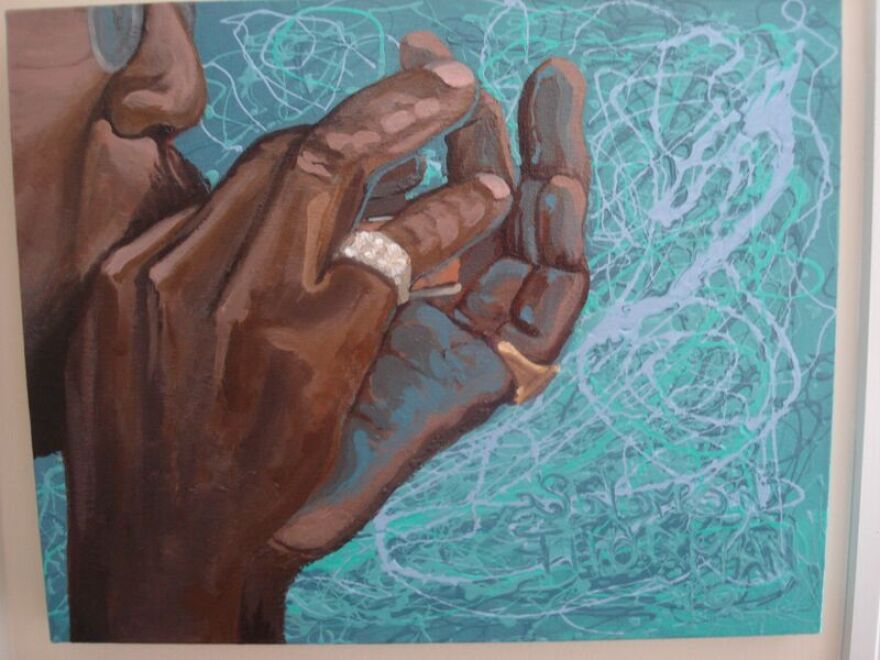Pictures don’t lie, the saying goes. But according to collector Robert Green of St. Louis’ near north side, many historic photos and other renderings of African Americans fail to tell the truth, or at least the whole story.
One hundred seventeen of Green’s images make up an exhibit called "Indelible," opening Friday at The Sheldon Art Galleries.

Green, 60, hopes his collection — predominantly formal portraits of St. Louisans from the mid-to-late 1800s — will counter stereotypical images, which he said often depict exaggerated dancing or laziness. He also sees it as a response to other negative images, found in old lithographs and woodcuts.
“Big lips, big butts, big noses, etcetera, nappy hair and all that,” Green said. “It was Jim Crow imagery; it was the times.”
His collection tells a different story.
“African Americans were a dignified people,” Green said. “Coming up, I didn’t see photographs of that nature.”
Who was ‘Cousin Mary?’
Stamps on paper frames show most of Green's images were taken by photographers with studios in St. Louis. But he also owns an original 1860s photo of Frederick Douglass, born into slavery in Maryland, who became an eminent leader and intellectual.

Other famous out-of-towners in the collection include Millie and Christine McCoy. The conjoined twins from North Carolina lived the circus sideshow life for a time but were also very cultured. Both spoke several languages and were accomplished musicians and singers.
"They were called, ‘the two-headed nightingale,’” Green said. “They eventually made enough money to buy their freedom, and a plantation that had slaves on it.”
While much is known about the McCoy sisters and Douglass, of course, most of the other subjects remain a mystery. Who, exactly, was “Cousin Mary?”

We do know she was the cousin of "Jim Buckner's Mama," photographed in 1900 by Louis Steger in St. Louis. What about the “Man in Top Hat?" (pictured, above). Do we know anything other than the fact he wandered into Julius Saettele's St. Louis studio sometime during the 1880s?
“Most of them don’t have a story behind them. It’s been lost with time,” Green said.
Green’s passion began in 1996 at a flea market. He saw another browser purchase an old portrait of an African-American individual in a formal setting.
“It piqued my curiosity,” he said.
Since then, he’s amassed a group of 200 images, which provide a history lesson in early photography, with its ambrotypes, tintypes and albumen prints.
Green’s larger collection does have some negative images. These includephotographs of lynchings, which were once popular as postcards, among some whites.
“I collect these just to show folks what my collection is responding to,” Green said.
Negative images 'a kind of backlash'

Green's collection resonates with an exhibition on display at the new National Museum of African-American History and Culture, according to Washington University professor of art history and archeology Angela Miller. The exhibit includes family photos, contributed by the public.
"This is part and parcel of the same history but it's a history that the Green collection is really tracking back into the 19th century," Miller said. "Even scholars have only tracked this history back to the 1920s."
The kinds of negative images that Green mentioned were a pushback against African-American progress.
"The rise of black civil rights, voting rights and so forth, produced a kind of backlash in the popular media and an effort to sort of put blacks in their place," Miller said.
It's critical for all Americans to view positive images such as those in Green's collection.
"This is one of the jobs of historians and collectors and museums, as institutions, to make this material available to us so that we have a more accurate and broader picture of our nation's history in all of its variety," Miller said.
Local painter’s 40-year career also on display

Another of the exhibits opening Friday night at The Sheldon, features the work of St. Louis painter Solomon Thurman. ‘Solomon Thurman: An Artistic Practice’ is an overview of the artist’s 40-year career.
Thurman’s work documents African Americans with an emphasis on the African diaspora. The exhibit includes work from several of his series, including paintings featuring migration, field songs and highway landscapes.
Thurman and his wife, Patricia Thurman, own the 10th Street Gallery, a member of the local Alliance of Black Art Galleries.
THE BASICS
‘Indelible: Historic African-American Photographs and Artifacts from the Collection of Robert E. Green’ and ‘Solomon Thurman: An Artistic Practice’ and three more shows
Where: The Sheldon, 3648 Washington Blvd., 63108
When: Opening reception 5-7 p.m., Friday, June 5.
How much: Free
Information: Sheldon website
Follow Nancy Fowler on Twitter: @NancyFowlerSTL










